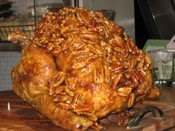
The Orange Zinfandel Turkey is one of our favorites around here. While we don't get Seville Oranges in Brooklyn they are very popular and easy to find in the markets in Paris.
Marmalade made from these oranges are perhaps my favorite of all jams and jellies to make and eat and it is very easy to make your own marmalade with a brand-new, revolutionary technique found HERE.
You might be interested to know that Seville Orange Marmalade was created because of an error. Apparently an Englishwoman in 1700, the wife of a grocer, was stuck with some sour oranges that were bought cheaply from a boat that was carrying them from Seville. Since there was a storm, they wanted to get rid of their stock or oranges quickly, so the grocer bought them. But they were inedibly sour so his wife decided to try making jam from then, and viola!...Seville Orange Marmalade was invented.
A wonderful compliment to our fried turkey, orange marmalade is used in the glaze that creates the Orange Zinfandel Turkey.
Two quarts
Adapted from Room For Dessert (HarperCollins)
This was recently updated to include a pre-boiling of the orange pieces, simmering them in water until cooked through as some varieties of sour oranges tend to be resistant to cooking, and the pre-boiling ensures they'll be fully cooked.
6 Seville oranges (which can often be found in markets around the world in the mid-winter)
1 navel orange
10 cups (2.5 liters) water
pinch of salt
8 cups (1.6 kg) sugar
1 tablespoon Scotch (optional)
1. Wash oranges and wipe them dry. Cut each Seville orange in half, crosswise around the equator. Set a non-reactive mesh strainer over a bowl and squeeze the orange halves to remove the seeds, assisting with your fingers to remove any stubborn ones tucked deep within.
2. Tie the seeds up in cheesecloth or muslin very securely.
3. Cut each rind into 3 pieces and use a sharp chef's knife to cut the rinds into slices or cubes as thin as possible. Each piece shouldn't be too large (no more than a centimeter, or 1/3-inch in length.) Cut the navel orange into similar-sized pieces.
4. In a large (10-12 quart/liter) stockpot, add the orange slices, seed pouch, water, and salt, as well as the juice from the Seville oranges from step #1. Bring to a boil, then reduce to a simmer, and cook until the peels are translucent, about 20 to 30 minutes.
(At this point, sometimes I'll remove it from the heat after cooking them and let the mixture stand overnight, to help the seeds release any additional pectin.)
5. Stir the sugar into the mixture and bring the mixture to a full boil again, then reduce heat to a gentle boil. Stir occasionally while cooking to make sure it does not burn on the bottom. Midway during cooking, remove the seed pouch and discard.
6. Continue cooking until it has reached the jelling point, about 220F degrees, if using a candy thermometer. To test the marmalade, turn off the heat and put a small amount on a plate that has been chilled in the freezer and briefly return it to the freezer. Check it in a few minutes; it should be slighty jelled and will wrinkle just a bit when you slide your finger through it. If not, continue to cook until it is.
7. Remove from heat, then stir in the Scotch (if using), and ladle the mixture into clean jars. Sometimes I bury a piece of vanilla bean in each jar. (Which is a great way to recycle previously-used or dried-out vanilla beans.)


No comments:
Post a Comment